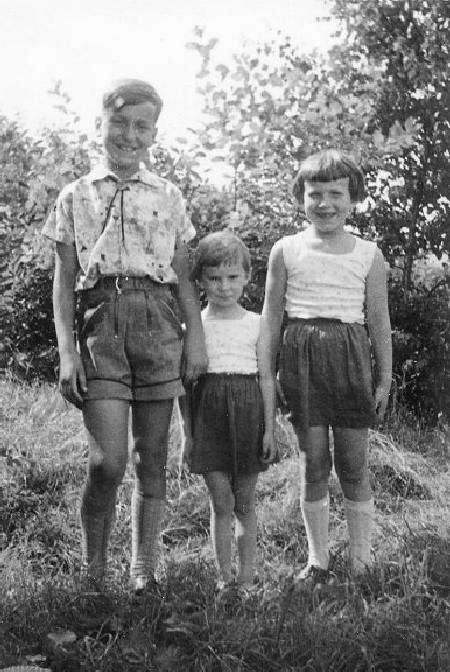
German Lederhosen: Other Clothing--Hosiery

Figure 1.--The most common hosiery worn with Lederhosen into the 1960s were kneesocls. After the 1960s it was ankle socks. There were other types of hosiery worn with Lederhosen. One was a special type only worn with Lederhosen as part of folk outfits.
|
|
The hosiery German boys wore with Lederhosen has varied over time. We note quite a range of hosiery types. Some were more associated with Lederhosen than others, in part because of the chronological period in which different hodiery types were popular. Kneesocks seem to have been the most common, but by the 1950s we see fewer boys wearing Lederhosen with knee socks and by the 1960s kneesocks were going out of style xo we see many boys wearing ankle socks with Lederhosen. We have noted boys wearing long stockings, but this was less common than knee socks. This was in part because many older boys wearing Lederhosen no longer wore long stockings. Also as Lederhosen were becoming increasingly common, long stockings were becoming less popular. We have also noted boys wearing tights, but this was not very common for short pants Lederhosen. It was somewhat more common for knicker-lengh Lederhosen. When not wearing the calf cuff, kneesocks were commonly worn with Lederhosen. The calf-cuffs seem to have been mostly worn as part of folk costumes. These are called split socks or "Loferl". Often we see boys wearng the bulky hand-knitted kneesocks.
Chronology
The hosiery German boys wore with Lederhosen has varied over time. We note quite a range of hosiery types. Some were more associated with Lederhosen than others, in part because of the chronological period in which different hodiery types were popular. We mostly see boys wearing Lederhosen with long stockings in the q1930s and 40s, but we still see some boys in the early 50s. This was relaztibely rate by the late-50s. Still we note a few examples. We note an unidentified boy in 1957.
We note German boys wearing all kinds of different types of hisiery with Lederhosen. Kneesocks seem to have been the most common, but by the 1950s we see fewer boys wearing knee socks and by the 1960s kneesocks were going out of style so we see many boys wearing ankle socks with Lederhosen. We have noted boys wearing long stockings, but this was less common than knee socks. This was in part because many older boys wearing Lederhosen no longer wore long stockings. Also as Lederhosen were becoming increasingly common, long stockings were becoming less popular. Still we see a number of boys wearing them. A good example is an unidentified family in the early 50s. We have also noted boys wearing tights, but this was not very common for short pants Lederhosen. It was somewhat more common for knicker-lengh Lederhosen. When not wearing the calf cuff, kneesocks were commonly worn with Lederhosen. The calf-cuffs seem to have been mostly worn as part of folk costumes. These are called split socks or "Loferl". Often we see boys wearng the bulky hand-knitted kneesocks.
Hosiery in Germany was highly seasonal during the first half of the 20th century. This was because most boys wore knee pants, bloomer knickers, or short pants. Thus to help keep warm during the winter, boys wore long stoickings. Girls did the same. There were other reasons for wearing long stockings (modesty and formality), but seasonality was very important. Many children had heavy long stockings for really cold weather. This began to change in the 1950s when long pants began to become more important. As a result, we see boys during the winter and the fall and spring wearing Lederhosen with long stockings. This could vary. Some mothers put out stockings based on the weather. Other mothers had an approximate date when they shifted from stockings to socks. Thus some children might wind up wearing long stockings on warm days or conversely socks on cool days. As far as we know there was no special association between Lederhosen and long stockings. Althiugh when worn for outdoor activities as opposed to school, we think boys often preferred socks and the older boys still wearing long stockings probably manahed to convince mothers on this.
Age
Age wasa factor in the hosiery worn with Lederhosen. Younger boys were more likrly to wear long stovkings with Lederhosen. An example is an unidentified boy about 1957.
Conventions
Demographics
Boys living in rural areas were most lijkely to wear Lederhosen with long stockings. This was because long stockings, especially after World War I, were more common in rural areas than in the more fashuionable cities.
HBC

Navigate the Boys' Historical Clothing Web Site casual pages:
[Return to the Main lederhosen page]
[Camp shorts]
[Clam diggers]
[Cord shorts]
[Jeans]
[Jump suits]
[Koveralls]
[Pinafore]
[Shortalls]
[Smocks]
[Soccer shorts]
Navigate the Boys' Historical Clothing Web Site Hosiery pages:
[Return to the Main lederhosen page]
[Ankel socks]
[Thre-quarter socks]
[knee socks]
[Long stockings]
[Tights]
[Loferl]
Navigate the Boys' Historical Clothing Web Site:
[Return to Main German lederhosen clothing page]
[Introduction]
[Activities]
[Biographies]
[Chronology]
[Clothing styles]
[Countries]
[Bibliographies]
[Contributions]
[FAQs]
[Glossaries]
[Images]
[Links]
[Registration]
[Tools]
[Boys' Clothing Home]

Created: 6:57 AM 9/3/2005
Last updated: 4:38 PM 7/20/2010


